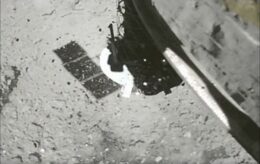Editor’s Note: This week we’re at the 242nd AAS meeting in Albuquerque, NM, and online. Along with a team of authors from Astrobites, we will be writing updates on selected events at the meeting and posting each day. Follow along here or at astrobites.com for daily summaries, or follow @astrobites on Twitter for live coverage. The usual posting schedule for AAS Nova will resume on June 12th.
Table of Contents:
Plenary Lecture: Meenakshi “Mini” Wadhwa (Arizona State University) (by Lucas Brown)
The final plenary lecture of AAS 242 was given Thursday morning by Dr. Meenakshi “Mini” Wadhwa from Arizona State University on the role of sample return missions in exploring the past and present of our solar system. From Apollo to Mars Sample Return, these missions have and will continue to provide unique and invaluable insight into the formation of our solar system, the origins of life, and beyond.
Sample return missions, which are missions to collect material directly from extraterrestrial sources, have existed since the 1960s, beginning with the Apollo missions. While it has been possible to study extraterrestrial materials for much of human history through examining meteorites which land on the surface of Earth, the utility of meteorites is limited by the fact that we don’t have direct context for their origins; where a particular meteorite originated from in the solar system is often unknown. Additionally, when these objects come into contact with Earth’s atmosphere and surface, their properties and composition can change relative to when they were floating through space. On the other hand, space missions are limited in how much analysis they can do due to constraints on the size and mass of satellites that can be launched on existing rockets. Dr. Wadhwa explained that bringing samples back enables higher resolution and more precise analyses, and it also allows for experiments to be reproduced across numerous labs and with multiple techniques — all increasing the reliability of the results. Additionally, sample return missions greatly increase the number of researchers who can be involved in analysis, and these missions can inspire the broader public. To give a specific example of the impact of a past sample return mission, the return of lunar regolith and rock samples during the Apollo missions led to the finding of the first evidence of magma oceans in the Moon’s early formation history, which is now foundational in many theories attempting to explain the formation history of rocky planets.

Still image from a video taken by the Hayabusa2 spacecraft depicting the cloud of debris ejected from the surface of asteroid Ryugu after the spacecraft launched a copper projectile into it. The spacecraft was able to collect subsurface material from this cloud of debris, later returning the material to Earth for analysis. [JAXA]

An ambitious plan is in the works to return samples of material from the surface of Mars known as Mars Sample Return. The Perseverance Mars rover has already collected samples into sealed canisters which have been deposited onto the surface for later retrieval. One such canister is visible in the foreground of this photo, with the location of others also being highlighted. [NASA/JPL-Caltech/ASU/MSSS]

